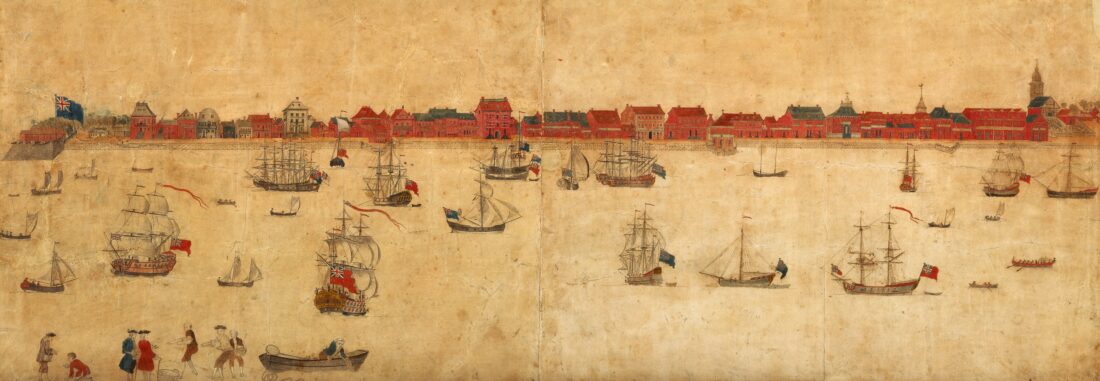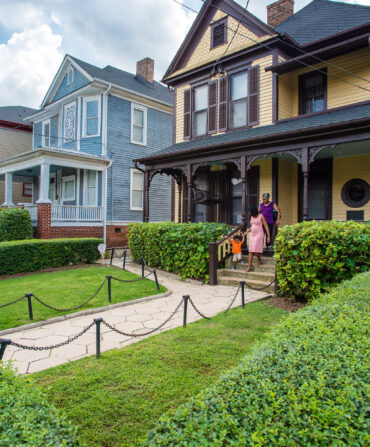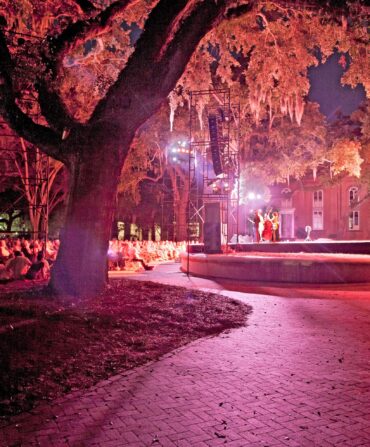Most fifth graders can tell you about the Boston Tea Party, the wild raid that took place in Boston Harbor on December 16, 1773, in protest of Britain’s Tea Act. But what about a similar act of defiance that occurred 978 miles south—and thirteen days prior—when another East India Tea Company ship sailed into Charles Towne Harbor? Fewer Americans know that story, but four Lowcountry organizations are doing their part to change that.

On Saturday, December 2, Charleston’s Powder Magazine Museum will reenact the city’s 1773 tea party protest at a live outdoor performance at the intersections of Broad and East Bay Streets. The reenactment—a partnership with Oliver Pluff & Co. tea company, the Old Exchange Building & Provost Dungeon, and the South Carolina Historical Society—will mark the 250th anniversary of that fateful day.
But what actually happened in Charleston in December 1773? And can the Holy City claim tea party supremacy? The answer’s murkier than the tea-stained waters of Massachusetts Bay.
First, it’s helpful to understand the stranglehold tea had on colonists up and down the coast. In today’s parlance, they were obsessed. In her book 1774, Mary Beth Norton, Cornell University’s Mary Donlon Alger professor of American History Emerita, calls American colonists “the greatest tea drinkers in the universe.” And that was especially true in port cities like Charleston.
Food scholar and author David S. Shields explains why. “When you think about what crossed the various oceans in the sixteenth and seventeenth centuries, they were all drugs,” Shields says. “Alcohol, sugar, coffee, and tea, capsaicin in terms of the hot peppers, tobacco—all of the great commodities were these things which created cravings and consumption culture, and were not greatly nutritive.”
Just as with today’s drugs, they also created a thriving illegal trade. In 1773, the market for illicit tea—typically called Dutch tea, untaxed and smuggled into colonial ports—was booming. “There was lots and lots of smuggled tea,” Norton says. “Some people who study the tea trade have said that in North America before the Tea Act, 90 percent was smuggled.”
Therein lay the rub: The East India Company had maintained a monopoly on British tea exports since 1600 and with that, a symbiotic relationship with the British monarchy and parliament. Naturally, Parliament wanted more colonists to buy East India tea, so they utilized the Tea Act to give the company financial relief, reduce the price of legal tea, and compel the colonists to buy it. “They wanted to prop up the East India Company because the members of Parliament were—guess what?—investors in the East India Company,” Norton says.
Now, put yourself in the shoes of the Charlestonians. You love tea. You’ve got to have it. There’s no way you’re inviting the Pinckneys or Rutledges over for supper without the finest and freshest Bohea, Singlo, or Hyson in your porcelain cups. But now Parliament is trying to play you for a fool by attempting to regain a monopoly on tea sales while taxing you without representation. Adding insult to injury, you get word that Captain Alexander Curling’s ship, the London, is about to dock at Charles Towne Harbor with 257 chests of East India Company tea. Now you’re boiling over with rage.
The London, one of seven ships that set sail for the American colonies in October 1773, arrived in Charles Towne on December 2, a date many submit as proof that Charleston beat Boston to the tea party punch. The Powder Magazine Museum describes it this way:
“Charlestonians, the very next day, confronted the ship, its captain, and the local merchants who were to receive the tea. This act of defiance and the non-import agreement authored on the third happened a full thirteen days before Bostonians more famously dumped the East India Company tea into Boston harbor on December 16, 1773.”
“I think it’s now a friendly history rivalry between the two cities,” Katherine Pemberton, the director of the Powder Magazine, says. “Boston’s tea-laden ship lands before ours does, but our protest meeting was on December 3 and theirs was on the sixteenth,” she says. “The two events play out differently—I think you could make the case for ‘first’ either way. Depends on where you live!”
But was Charleston’s protest meeting first? Norton points out that the Dartmouth, one of the seven tea ships, had arrived in Boston on November 28, “triggering a call for an immediate meeting, which was announced in handbills posted all over town the next morning.” Residents were asked to gather at Faneuil Hall at 9 a.m. on November 29. Two days of meetings ensued and participants unanimously voted to prevent the tea from landing.
Such consensus in Charleston was elusive, Norton adds. After the city’s own first meeting in the Exchange Building’s Great Hall (which was so packed the floorboards groaned from the weight), merchants and planters left confused as to whether a course of action had been decided. “So they had another meeting, then two more meetings and some interim meetings,” Norton says. “The crucial point is that Charleston couldn’t make up its mind what to do.”
Eventually, the city leaders decided to let customs officers confiscate the tea. And so on December 22—six days after the Boston Tea Party—hired laborers, under the employ of royal officials, seized the tea chests and placed them in the Exchange Building basement. There they sat for the next three years until patriots sold them to fund America’s war for independence.
Can we call that a tea party? Norton calls it Charleston dysfunction.
But even if every quill-ink-stained calendar from 1773 technically points to Boston as having held the first protest meeting and the first confiscation of the cargo, one can understand Charleston’s desire for a little more credit, as the two events played out essentially simultaneously. And whether you prefer to remember the tea party as a Boston story or a Charleston story, one thing’s for sure: It’s a quintessential American story.








